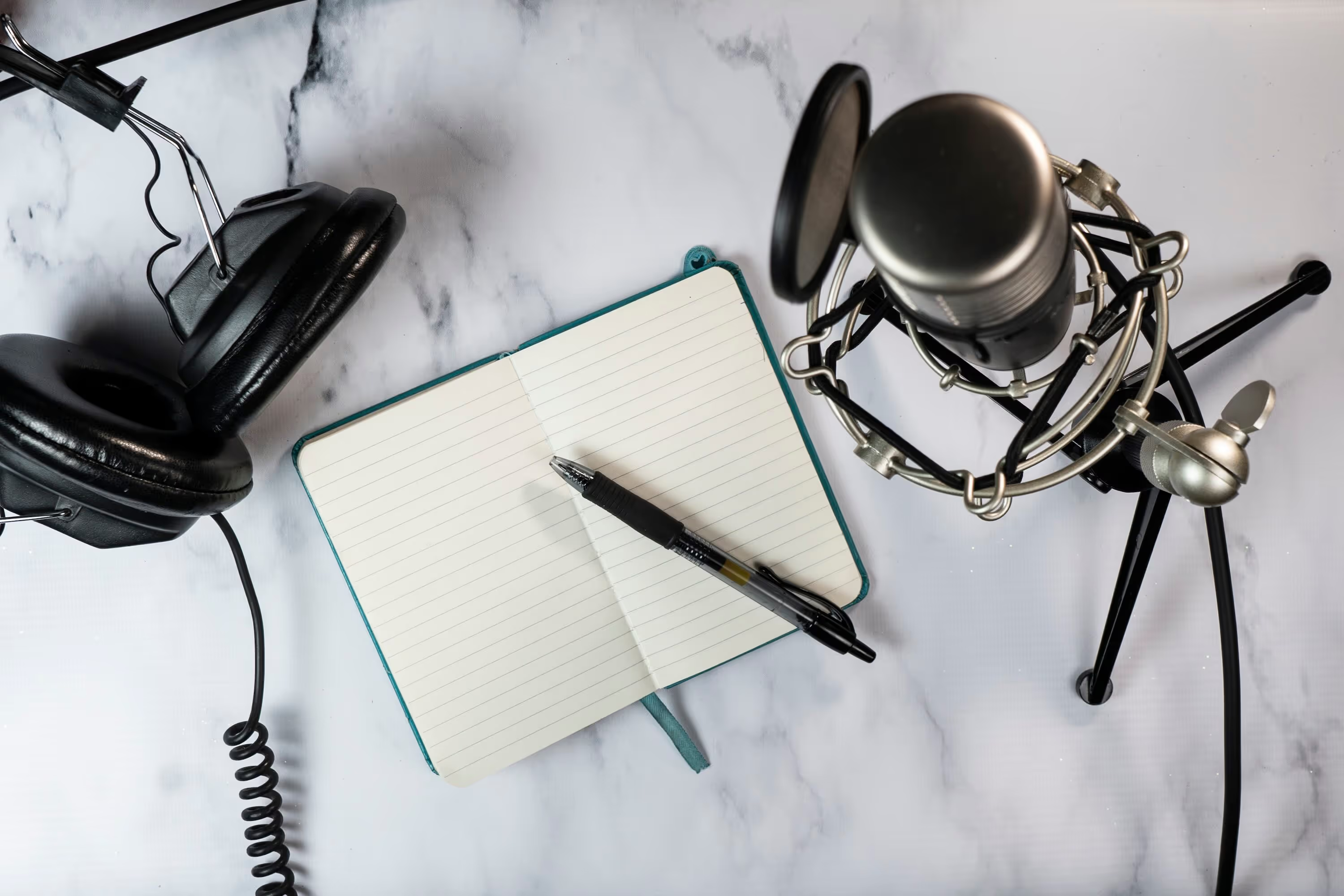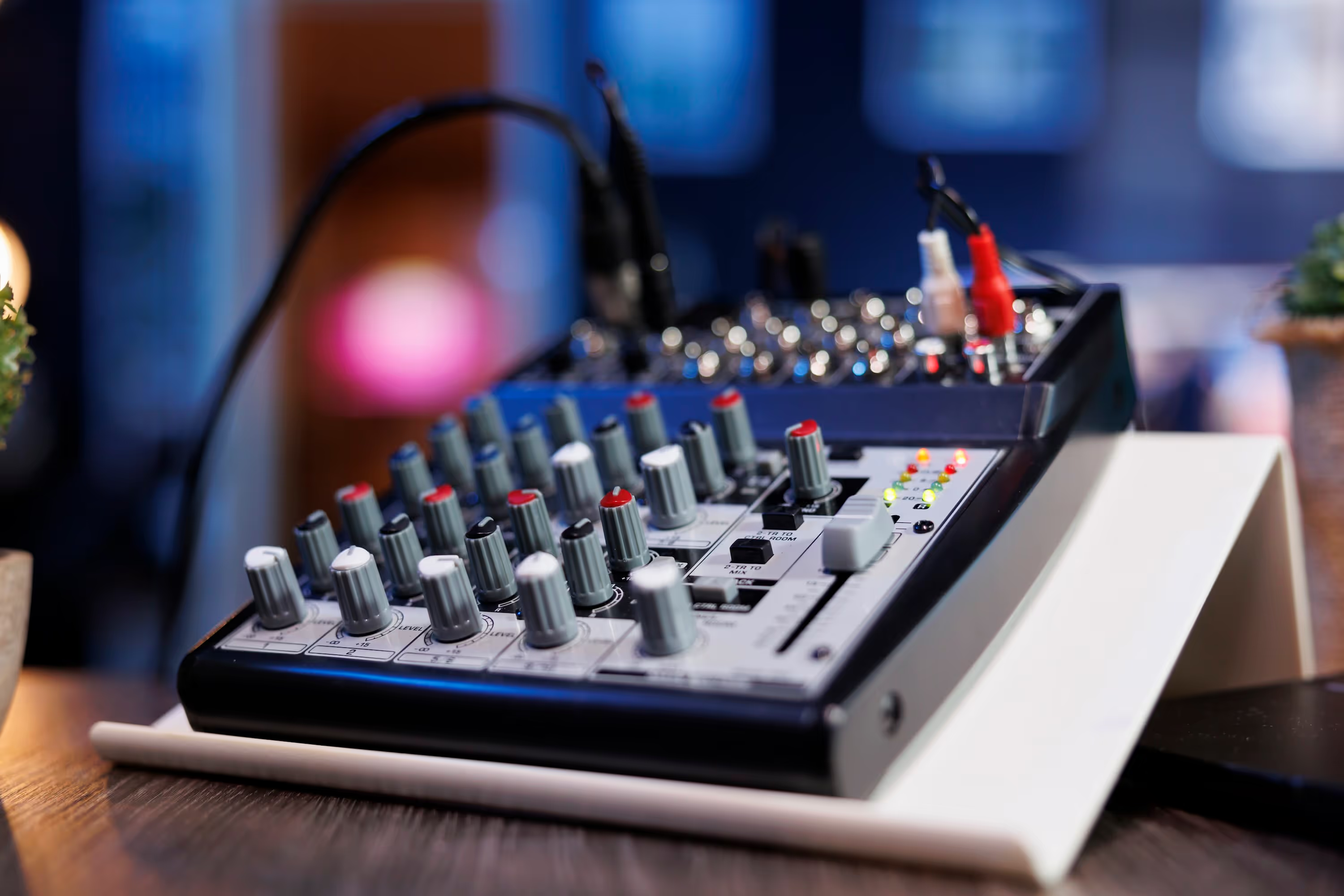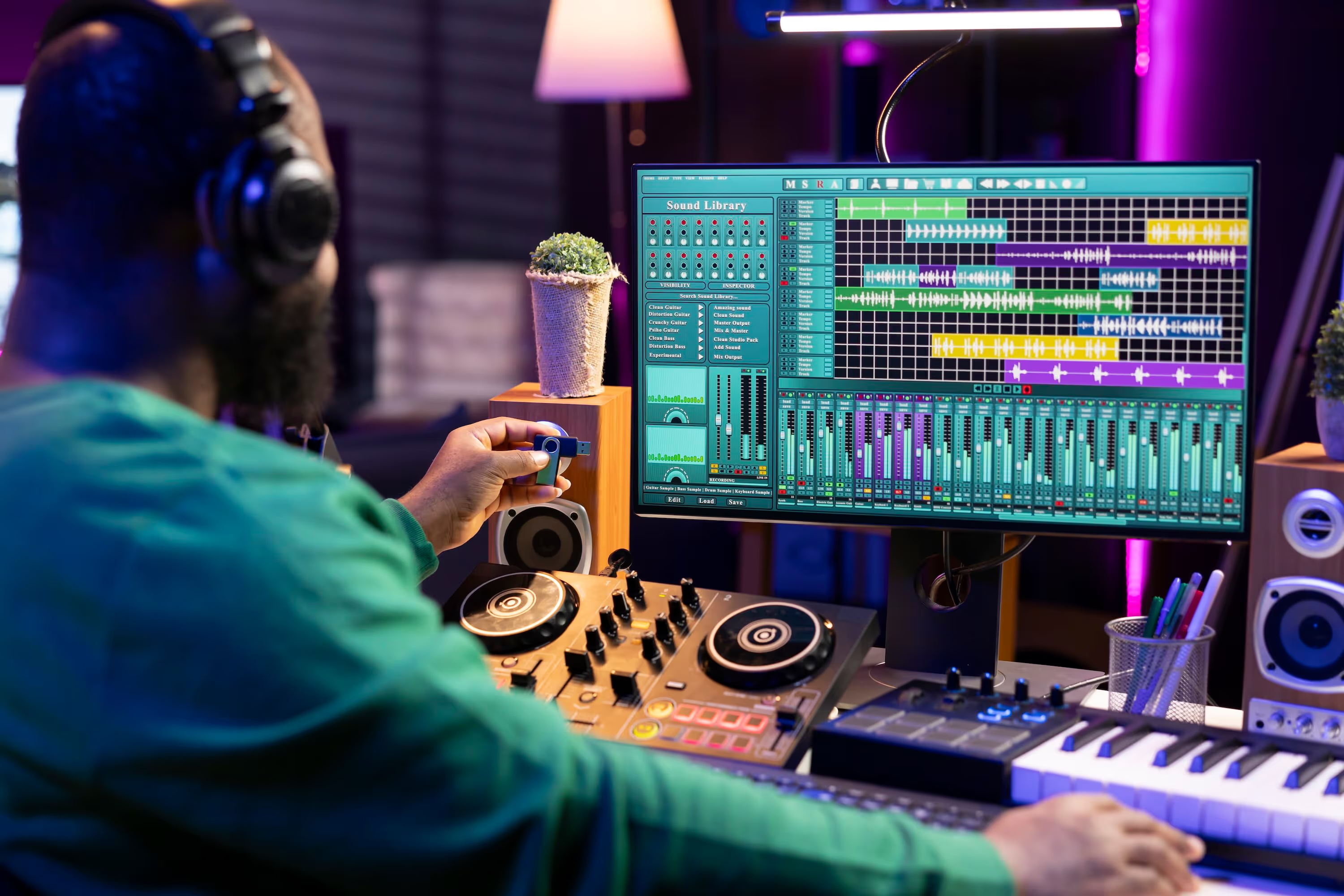
Let's Talk
Menu

The belief that podcasting is still a niche hobby in 2025 couldn’t be further from the truth. It’s one of the fastest-growing forms of media worldwide. From independent storytellers to major brands, more people are turning to podcasts to share knowledge, build communities, and strengthen their voice. But creating a podcast that sounds polished and connects with listeners isn’t as simple as grabbing a mic and talking.
Think you can just wing it? Have you planned your concept so it actually holds together? Chosen a format that won’t make listeners switch off? Got the right equipment to avoid hiss, pops, and echoes? And editing, are you ready to spend hours trimming, mixing, and polishing each episode? Then there’s publishing, distribution, and audience strategy, none of which are exactly casual afternoon projects.
Does it all sound like too much? Fear not. This podcast production guide walks you through the full journey: planning your concept, defining your audience, recording, editing, and publishing episodes that actually reach listeners. Or, if you’d rather skip the chaos, Cue Podcasts can handle it all. We take care of planning, recording, editing, polishing, and distribution so your podcast sounds professional, reaches the right audience, and lets you focus on what matters: your content. Think of it as your backstage pass to smooth, stress-free production.
Planning is the foundation of every successful podcast. Without it, even the best ideas risk coming across as inconsistent, unclear, or forgettable. A well-thought-out plan ensures every stage, from recording to publishing, runs smoothly and that your episodes genuinely resonate. Whether you’re a marketing professional looking to engage clients, a thought leader sharing expertise, or an ambitious creator launching your first show, careful planning is essential.
Start by identifying the core idea behind your podcast. Keep it focused but flexible. Examples include:
A clear concept makes your podcast memorable and gives listeners a reason to return. Too broad, and your message risks being lost; too narrow, and you may quickly run out of content. Cue Podcasts works closely with you to refine your concept, ensuring it aligns with your objectives, audience expectations, and long-term content strategy.
Your format dictates the rhythm of your episodes and shapes how your audience experiences your content. Consider these options:
Experiment at the start, but consistency is critical. And if you’re unsure, our team brings a wealth of experience across all podcast formats, from solo commentary to narrative storytelling and panel discussions. The experts at Cue can advise on what’s most likely to resonate with your audience, helping you choose a format that fits your goals while avoiding common pitfalls. That way, you’re not guessing, you’re making informed decisions backed by professional insight and proven strategies.
Understanding who your podcast is for is one of the most important steps. Ask yourself: Who are they? What challenges or questions do they have? How do they consume content? Even beginners can access tools to start this research:
It can feel overwhelming to gather and interpret all this data. That’s where Cue Podcasts comes in. Our team handles audience analysis, market sizing, and content positioning so you don’t have to. We combine industry-standard analytics tools with experience in podcast strategy to ensure your show is targeted, discoverable, and designed to engage the right listeners from day one.
A clear structure keeps recording manageable, editing simpler, and ensures a professional final result. A template that works for most shows includes:
Consistency builds trust. Cue Podcasts helps map out this structure for each episode, providing scripts, outlines, and production workflows so every episode feels polished and on-brand. The result is a professional podcast that elevates your content without adding stress or endless hours of preparation.

Having the right tools is critical for creating a podcast that sounds professional. Even the strongest ideas can fall flat if your audio is poor, distracting, or inconsistent. That said, you don’t need to invest in a full studio on day one. What truly matters is knowing what equipment and software will give you the results you need.
Your microphone is arguably the most important piece of kit. It’s the difference between a podcast that sounds amateur and one that feels broadcast-ready. Choosing the right mic depends on your environment, content, and experience level.
Unsure of the right microphone for you? Cue Podcasts can advise on the best mic for your setup and handle both in-studio and remote recordings, ensuring your voice comes through clear and professional every time.
A good pair of headphones is just as important as a quality microphone. They let you hear exactly what’s being recorded, catch background noise, monitor levels in real-time, and ensure your episodes sound polished. Choosing the right headphones depends on your environment, content style, and workflow.
At Cue Podcasts, we ensure all hosts and guests use high-quality headphones, whether in our studios or remotely, so you monitor every session clearly and confidently.
Your digital audio workstation, or DAW for short, is where your podcast is recorded, edited, and polished. Choosing the right DAW is crucial because it affects workflow, sound quality, and how easily you can manage multiple tracks, guests, and effects. The best option will come down to your experience level, production complexity, and whether you plan to handle editing in-house or with professional support.
Here are some key considerations to help narrow down the right DAW for your show:
Not sure which DAW is right for you? Cue can set up your DAW and manage all technical details, ensuring your recording workflow is smooth and optimised, whether in-studio or remote.
Small additions can make a surprisingly big difference to the quality of your podcast. These aren’t just “nice-to-haves”, they help your episodes sound professional, reduce technical headaches, and save time in editing:
Cue Podcasts handles all setup, testing, and optimisation of accessories and recording environments, giving you professional-quality audio without having to worry about technical details. Whether using our in-studio facilities in London, New York, Manchester, Dublin, or Lisbon, or recording remotely, we make sure every episode is broadcast-ready from the start.
Recording your podcast might feel simple, just speak into a mic and hit record. And while that may work for amateur creators, professional-quality audio requires attention to detail. Poor sound quality or inconsistent recordings can undermine even the strongest content. Following best practices ensures your sessions are smooth, efficient, and broadcast-ready.
Cue Podcasts manages all pre-session setup and sound checks for both in-studio and remote recordings, so your sessions start perfectly every time.
Remote interviews are increasingly common, especially when sourcing experts or customers from different locations. Local track recording tools, such as Riverside.fm or SquadCast, ensure each participant’s audio is captured at high quality, even if internet connections fluctuate.
Cue Podcasts coordinates both in-studio and remote sessions, managing mic placement, monitoring, and local track capture to guarantee every recording is broadcast-quality.

Editing transforms raw recordings into polished episodes that captivate and retain listeners. It’s where podcasts evolve from amateur-sounding content to professional shows that reflect your brand’s credibility and authority.
Cue Podcasts handles full post-production, mixing, and mastering, delivering episodes that are polished, on-brand, and ready for distribution. Our team ensures the audio quality consistently meets professional standards, whether you’re producing a company podcast or a personal thought-leadership series.
Creating high-quality content is just the beginning. To make an impact, your podcast needs to consistently reach the right audience.
Cue Podcasts manages hosting, scheduling, and distribution while providing detailed analytics and performance insights. We ensure every episode is discoverable, delivered on time, and strategically positioned to reach your target listeners without the guesswork.

Producing a professional podcast can feel daunting, especially when balancing strategy, recording, editing, and promotion. Cue Podcasts offers a full-service solution that combines expertise, technical resources, and creative guidance to simplify the process.
Partnering with Cue Podcasts allows marketing teams, thought leaders, and ambitious creators to focus on content while leaving technical, operational, and strategic details to professionals. The result is a polished, professional podcast that strengthens your voice, engages your audience, and positions your brand or expertise for maximum impact.
Producing a professional podcast involves more than recording audio. It’s a structured, creative process, designed to take your idea from concept to launch while ensuring each episode resonates with your audience. Unlike some competitors who rely heavily on AI for content and production, Cue Podcasts focuses on experience-led, human insight at every stage, combining creative expertise with proven podcasting techniques.
Here’s how Cue Podcasts works, step by step.
Every podcast begins with a conversation. When you reach out to Cue, we arrange a consultation call to understand your ideas, goals, and the context behind your brand or personal project. This isn’t just a quick chat; it’s the first stage of a collaborative journey.
During the consultation, we usually cover:
The goal of this step is to establish a clear starting point. It ensures that every subsequent stage is grounded in your vision and objectives, whether your aim is to create thought-leadership content, engage clients, or launch a branded series.
Once we have a clear understanding of your brand and vision, the next stage is research. This step ensures your podcast is strategically positioned to engage the right listeners and stand out in a competitive landscape.
Cue Podcasts begins by analysing your audience: who they are, what interests them, and what challenges or questions they may have. We then evaluate your industry and competitors to identify gaps in the content market, uncover trends, and highlight opportunities for differentiation.
Key activities in this stage include:
For marketing teams and thought leaders, this step ensures your podcast is not just another piece of content, but a strategic asset that supports your broader communication goals. Cue Podcasts handles all aspects of this research, combining data-driven insight with creative expertise, so you can be confident your show is targeting the right audience from the outset.
With research complete, we move into the creative phase. This is where ideas begin to take shape and your podcast starts to have a defined identity.
Cue Podcasts collaborates with you to:
Our team has extensive experience across formats and can advise on what will resonate with your audience, helping you avoid common pitfalls. For marketing teams, this step ensures the podcast aligns with brand voice and strategic messaging while being engaging and memorable.
Before recording, careful planning ensures every episode is organised and on-brand. During pre-production, Cue Podcasts manages:
This stage removes logistical headaches, so your team can focus on content rather than technical or operational details.
Recording is where your podcast becomes tangible. Cue Podcasts ensures a seamless experience, whether in-studio, on-location, or remote. Key elements include:
The aim is a smooth, professional recording experience that reflects your brand’s voice and resonates with your audience.
After recording, every episode is meticulously edited and enhanced. Cue Podcasts handles:
This ensures your podcast feels polished, immersive, and professional – whether it’s a thought-leadership series, brand podcast, or ambitious personal project.
Once episodes are finalised, Cue Podcasts takes care of publishing and distribution:
This allows marketing teams and creators to reach their target audience seamlessly, without the technical burden of platform management.
Publishing is just the beginning. Promotion helps your podcast gain traction:
Cue Podcasts ensures your show gets noticed, turning each episode into an opportunity to engage audiences and reinforce your messaging.
Understanding performance is key to growth and optimisation. Cue Podcasts provides:
This allows brands, thought leaders, and creators to make informed decisions about future episodes, maximising the impact of each podcast.
While the steps outlined in this podcast production guide provide a clear roadmap for creating a professional podcast, executing them effectively is a different story. Marketing teams, thought leaders, and ambitious creators alike face decisions around planning, recording, editing, publishing, and promoting episodes, with each step requiring time, expertise, and careful attention to detail.
Cue Podcasts makes the process simpler and stress-free. We manage every stage, from in-studio or remote recording to polished post-production, distribution, and promotion. By combining industry knowledge, technical expertise, and creative insight, we ensure your podcast sounds professional, resonates with your target audience, and aligns perfectly with your brand voice or personal vision.
At Cue Podcasts, we bring your ideas to life, ensuring your podcast is always memorable, engaging, and impactful without the logistical burden. Contact us today and see how effortless professional podcast production can be.

Join our carefully curated newsletter packed with insights, tips and resources to help shape and share your stories.